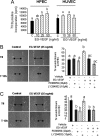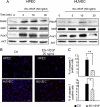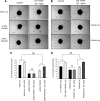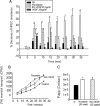Molecular characterization of EG-VEGF-mediated angiogenesis: differential effects on microvascular and macrovascular endothelial cells
- PMID: 20587779
- PMCID: PMC2921113
- DOI: 10.1091/mbc.E10-01-0059
Molecular characterization of EG-VEGF-mediated angiogenesis: differential effects on microvascular and macrovascular endothelial cells
Abstract
Endocrine gland derived vascular endothelial growth factor (EG-VEGF) also called prokineticin (PK1), has been identified and linked to several biological processes including angiogenesis. EG-VEGF is abundantly expressed in the highest vascularized organ, the human placenta. Here we characterized its angiogenic effect using different experimental procedures. Immunohistochemistry was used to localize EG-VEGF receptors (PROKR1 and PROKR2) in placental and umbilical cord tissue. Primary microvascular placental endothelial cell (HPEC) and umbilical vein-derived macrovascular EC (HUVEC) were used to assess its effects on proliferation, migration, cell survival, pseudovascular organization, spheroid sprouting, permeability and paracellular transport. siRNA and neutralizing antibody strategies were used to differentiate PROKR1- from PROKR2-mediated effects. Our results show that 1) HPEC and HUVEC express both types of receptors 2) EG-VEGF stimulates HPEC's proliferation, migration and survival, but increases only survival in HUVECs. and 3) EG-VEGF was more potent than VEGF in stimulating HPEC sprout formation, pseudovascular organization, and it significantly increases HPEC permeability and paracellular transport. More importantly, we demonstrated that PROKR1 mediates EG-VEGF angiogenic effects, whereas PROKR2 mediates cellular permeability. Altogether, these data characterized angiogenic processes mediated by EG-VEGF, depicted a new angiogenic factor in the placenta, and suggest a novel view of the regulation of angiogenesis in placental pathologies.
Figures








Similar articles
-
EG-VEGF controls placental growth and survival in normal and pathological pregnancies: case of fetal growth restriction (FGR).Cell Mol Life Sci. 2013 Feb;70(3):511-25. doi: 10.1007/s00018-012-1141-z. Epub 2012 Sep 2. Cell Mol Life Sci. 2013. PMID: 22941044 Free PMC article.
-
Diversity in human placental microvascular endothelial cells and macrovascular endothelial cells.Cytokine. 2018 Nov;111:287-294. doi: 10.1016/j.cyto.2018.09.009. Epub 2018 Sep 27. Cytokine. 2018. PMID: 30269024
-
Revisiting the role of hCG: new regulation of the angiogenic factor EG-VEGF and its receptors.Cell Mol Life Sci. 2012 May;69(9):1537-50. doi: 10.1007/s00018-011-0889-x. Epub 2011 Dec 3. Cell Mol Life Sci. 2012. PMID: 22138749 Free PMC article.
-
The multiple roles of EG-VEGF/PROK1 in normal and pathological placental angiogenesis.Biomed Res Int. 2014;2014:451906. doi: 10.1155/2014/451906. Epub 2014 May 15. Biomed Res Int. 2014. PMID: 24955357 Free PMC article. Review.
-
Unique expression and regulatory mechanisms of EG-VEGF/prokineticin-1 and its receptors in the corpus luteum.Ann Anat. 2005 Nov;187(5-6):529-37. doi: 10.1016/j.aanat.2005.07.005. Ann Anat. 2005. PMID: 16320832 Review.
Cited by
-
Characterization of the adverse effects of nicotine on placental development: in vivo and in vitro studies.Am J Physiol Endocrinol Metab. 2014 Feb 15;306(4):E443-56. doi: 10.1152/ajpendo.00478.2013. Epub 2013 Dec 24. Am J Physiol Endocrinol Metab. 2014. PMID: 24368670 Free PMC article.
-
Novel Insights into Prokineticin 1 Role in Pregnancy-related Diseases.Int J Med Sci. 2024 Jan 1;21(1):27-36. doi: 10.7150/ijms.76817. eCollection 2024. Int J Med Sci. 2024. PMID: 38164347 Free PMC article. Review.
-
Effects of Prokineticins on Cerebral Cell Function and Blood-Brain Barrier Permeability.Int J Mol Sci. 2023 Oct 21;24(20):15428. doi: 10.3390/ijms242015428. Int J Mol Sci. 2023. PMID: 37895111 Free PMC article.
-
Prokineticin 1 is up-regulated by insulin in decidualizing human endometrial stromal cells.J Cell Mol Med. 2018 Jan;22(1):163-172. doi: 10.1111/jcmm.13305. Epub 2017 Aug 7. J Cell Mol Med. 2018. PMID: 28782224 Free PMC article.
-
Endothelial activation and injury by microparticles in patients with systemic lupus erythematosus and rheumatoid arthritis.Arthritis Res Ther. 2019 Jan 23;21(1):34. doi: 10.1186/s13075-018-1796-4. Arthritis Res Ther. 2019. PMID: 30674349 Free PMC article.
References
-
- Burton G. J., Jauniaux E. Sonographic, stereological and Doppler flow velocimetric assessments of placental maturity. Br. J. Obstet. Gynaecol. 1995;102:818–825. - PubMed
-
- Charnock-Jones D. S., Burton G. J. Placental vascular morphogenesis. Baillieres Best Pract. Res. Clin. Obstet. Gynaecol. 2000;14:953–968. - PubMed
-
- Charnock-Jones D. S., Kaufmann P., Mayhew T. M. Aspects of human fetoplacental vasculogenesis and angiogenesis. I. Molecular regulation. Placenta. 2004;25:103–113. - PubMed
-
- Chen J., Kuei C., Sutton S., Wilson S., Yu J., Kamme F., Mazur C., Lovenberg T., Liu C. Identification and pharmacological characterization of prokineticin 2 beta as a selective ligand for prokineticin receptor 1. Mol. Pharmacol. 2005;67:2070–2076. - PubMed
-
- Dellian M., Witwer B. P., Salehi H. A., Yuan F., Jain R. K. Quantitation and physiological characterization of angiogenic vessels in mice: effect of basic fibroblast growth factor, vascular endothelial growth factor/vascular permeability factor, and host microenvironment. Am. J. Pathol. 1996;149:59–71. - PMC - PubMed
Publication types
MeSH terms
Substances
LinkOut - more resources
Full Text Sources
Other Literature Sources

